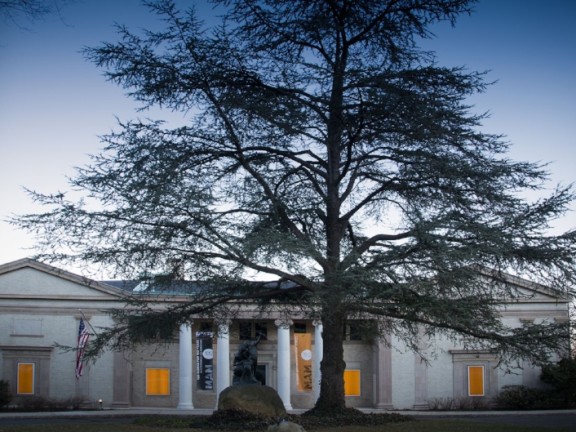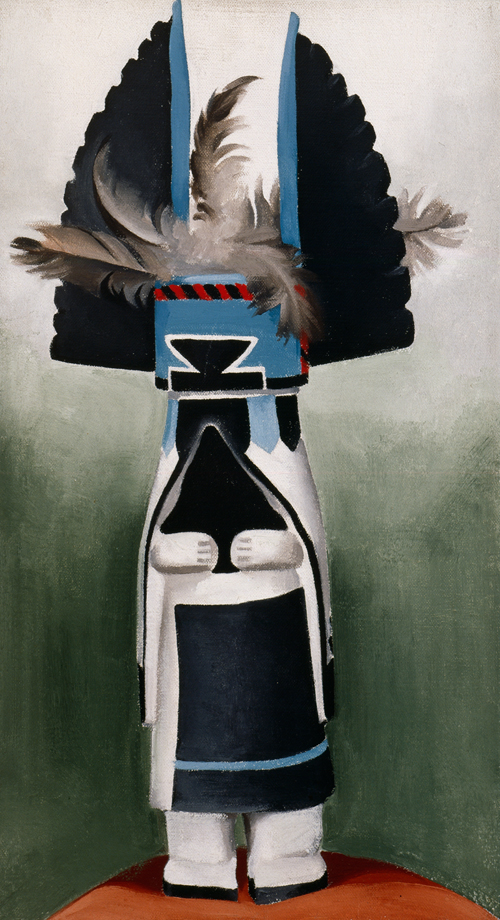Georgia O'Keeffe: New Mexico to Montclair

Practically anyone who’s ever taken a grade-school art class knows Georgia O’Keeffe as “the flower painter.” That’s her trademark: extreme, colorful close-ups of flora. To some, they’re gorgeous, detailed depictions of nature. To others, they’re visual metaphors for certain parts of the female anatomy. Either way, they’ve overshadowed the rest of her work. “The flowers have taken over,” laments Carolyn Kastner, an O’Keeffe expert. “And flowers aren’t even the majority of the work she created in her lifetime. She was annoyed by it, too.” An exhibit at the Montclair Art Museum now through Jan. 20 delves deeper into a largely unknown aspect of the artist's lifework. “Georgia O’Keeffe in New Mexico: Architecture, Katsinam, and the Land” examines the pieces she produced during the yearly visits she made to the 47th state from 1929-53. On the walls are more than 45 paintings — of porcelain roosters, of Native American dolls, of mud-hut churches. They go beyond the “O’Keeffe we all think we know,” Kastner says. “When she came to New Mexico in 1929, you can think of it like a hinge on her career,” explains Kastner, who is associate curator at the Georgia O’Keeffe Museum in Santa Fe, where the traveling exhibit originated. (The stop in Montclair marks its premiere.) “It was an explosion of creativity. It was an explosion of new ideas.”

O’Keeffe (1887-1986) was already famous when she started visiting the Land of Enchantment. Her husband, Alfred Stieglitz, was a noted photographer and gallery organizer who “brought attention to the sexuality of her flowers,” Kastner says. At one of the first shows Stieglitz presented of his wife's work, he introduced nude photographs he had taken of her. That gave O’Keeffe instant notoriety.
“She really spent the rest of her life — and we do it now at the museum — trying to explain that wasn’t her idea,” Kastner says. “That was Alfred Stieglitz’s.” The outdoors always intrigued O’Keeffe, who was born in Wisconsin and lived in Virginia and Texas. She once passed through New Mexico on a trip with her sister. “She writes about that: ‘I was always trying to get back to New Mexico,’” Kastner recalls. O’Keeffe made her way back in 1929, staying at the home of famed arts patron Mabel Dodge Luhan. The visit proved prolific: In four or five months there, O’Keeffe crafted 23 paintings. After that, she returned to the state nearly every year until 1953. “Almost all of it was new to her,” Kastner explains. “She had created flowers, obviously, before, and she had studied landscape. But not this landscape. So she began to focus on these diverse subjects.” One of the qualities that changed was O’Keeffe’s palette. She was suddenly “overwhelmed by colors,” Kastner says. This is evident in one of the exhibit’s most striking depictions: “Rust Red Hill” (1930), a painting of a mountain range with distinct dark red, blue and brown hues. “You think this is an exaggeration,” Kastner says of the piece. “But when you get (to New Mexico), you realize: No, it’s this exotic, highly colored, volcanic landscape. The reds, the purples, the pinks.”

Another highlight is “Bear Lake” (1930). Luhan's husband, Tony, took O’Keeffe on a trip to the lake, and she responded by painting a giant tree rising into the dark, star-speckled sky, with the light from a campfire illuminating the trunk. O’Keeffe was also drawn to still-life objects. Seen in Montclair are 15 paintings of Katsina (or Kachina) dolls, gifts given as part of religious ceremonies in the Hopi and Pueblo cultures. These representations of spirit beings are colorful but straightforward. She simply documented them, as a journalist would. “She wasn’t interested in understanding the religion,” Kastner notes. “She was interested in the objects themselves. That’s different from many of the modernists who were out in New Mexico at this time, who wanted to paint the rituals and the dancers.”
The exhibit offers a peek into O’Keeffe’s process, as well. “Ranchos Church” (1929) pictures a church made of adobe bricks, set against a light gray sky. Next to it hang her drawings of the building before she started painting.
Her trademark, however, isn’t missing entirely from the show. “Yellow Cactus” (1935) is a close-up of a bright yellow flower with a green prickly pear in the bottom right corner. Following the Montclair engagement, "Georgia O'Keeffe in New Mexico" continues at the Denver Art Museum (Feb. 10-April 28, 2013); the Georgia O'Keeffe Museum (May 17-Sept. 8, 2013); and the Heard Museum in Phoenix (Sept. 27, 2013-Jan. 12, 2014).
The Montclair Art Museum is at 3 S. Mountain Ave., Montclair, (973) 746-5555. Earlier this month, in partnership with Egan & Sons, the museum began "Free First Thursday Nights," offering free admission on first Thursdays from 5 to 9 p.m. "Free First Fridays" will also continue. During regular hours (Wednesdays-Sundays, noon to 5 p.m.) admission is $12 for adults, $10 for seniors and students, and free for children under 12.
1. Georgia O'Keeffe "Ranchos Church No. 1," 1929 Oil on canvas Collection of the Norton Museum of Art, West Palm Beach, Florida, Purchase the R.H. Norton Trust © Georgia O’Keeffe Museum Courtesy of the Georgia O'Keeffe Museum 3. Georgia O'Keeffe "Kachina," 1934 Oil on canvas Private Collection © Georgia O’Keeffe Museum Courtesy of the Georgia O'Keeffe Museum
